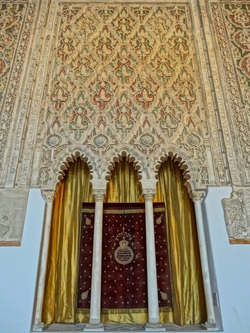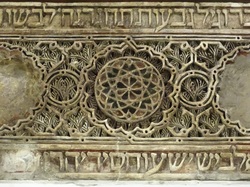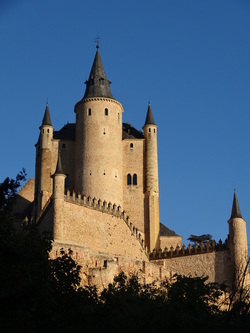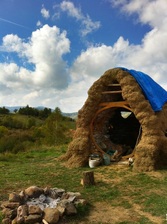



In our post on Andalusia, we started the story of the Jews in Spain during the rule of the Moorish Kingdoms. As we traveled to the central region of Spain to visit the capital of Madrid, we will end that story. Previously we learned that the Moorish Kingdoms were tolerant of the Jews, creating a golden age where Jewish culture and art thrived. But as more conservative factions came to rule in Moorish Spain, Jews fled to the territory of the Christian Kingdoms, where they were not killed largely because those kingdoms needed them in the fight against the Moors.  The Ark in El Transito Synagogue Much of the history comes to a head in Toledo. In 1085, Alfonso VI welcomed the fleeing Jews to Toledo by granting Jews equality with Christians and even some rights of the nobility. 40,000 Jews served in Alfonso VI’s army against the Moors, until a key battle was lost in 1108. The Jews were blamed and a riot broke out that killed many Jews and saw their homes and synagogues burned down while Alfonso lay on his deathbed, helpless to stop the madness. For the next 300 years patterns like this would continue where Jews were given a modicum of power by one ruler, only to be massacred and exiled by the next. By 1391, anti-Semitism reached a fever pitch and Jews were butchered in Seville, Cordoba, and Toledo. Corpses of women and children lay heaped in the streets and in destroyed synagogues.  Stucco work - El Transito From the massacres rose to popularity the Dominican Vincent Ferrer, who forced Jews to either convert or be forced to live in ghettos where nearly any livelihood was illegal as was flight from the country. But as Jews did convert, no one believed their faith and hatred of these “New Christians” was the dominant attitude. Thus were sown the seeds of the Spanish Inquisition, aimed at finding out if converted Jews (conversos) were authentic in their faith. By 1492, hatred of Jews was so strong that Isabelle and Ferdinand signed the edict of expulsion, which forced all unconverted Jews to leave the country forever, with all of their property and wealth confiscated by the state. The majority (90,000) fled to Turkey and the Ottoman Empire while 20,000 others died in the process of fleeing. Those converses who stayed were subjected to the torture and persecution of the Spanish Inquisition, which didn’t fully end until 1834. But despite the sadness about the oppression of minorities in medieval Spain, there were many beautiful sites to be seen. In Madrid the Palacio Real (Royal Palace), the Botanical Gardens, and the numerous beautiful piazzas were all impressive. In Toledo, the mudejar style of the surviving synagogues was beautiful and the huge cathedral there is impressive.  Alcazar in Segovia But perhaps most memorable for us was the picturesque town of Segovia, whose old city was fed by an aqueduct that reaches 28 meters at its tallest point. Built during Roman times to supply a fort on the hilltop that would become the city, the aqueduct uses no mortar (it is only stacked stones) and is truly an act of engineering genius, testified to by the fact that it still stands 2,000 years after its construction. It is amazing! The Alcazar (palace) in Segovia is equally beautifully – its Romantic style towers climbing into the sky on the site of the old Roman fort. Plopped down in the middle of the town between the Alcazar and Aqueduct is the last great Gothic Cathedral in Spain, also stunning. Walking down into the countryside in order to get views of the Alcazar and Cathedral as the sun set on the city was one of our favorite times in Spain. After the sun went down we sped home on our first trip ever on a high speed train – a mere 30 minute journey. After our day trips to Toledo and Segovia, we spent the day in the botanical gardens of Madrid, enjoying the landscaping and the beauty of the crystal palace there. Then it was off on a night bus to Barcelona, where we would have one of our most dangerous adventure yet! See all the pics of Madrid, Toledo and Segovia by clicking here.  Mudhouse Postscript: We are back in Bulgaria now and getting ready for our trip to India. But if you want to see some pics of our mountain adventure in Bulgaria with our friends Kaloyan and Rumiana, click here. We had great times visiting a Bulgarian masterpiece of a house (from the days of Turkish occupation) and helping to build a hobbit-like mudhouse at the Future Now volunteer project high up in the hills. After getting back from our trip, we spent a 13 hour day making homemade lutenitza, inspired by our Barcelona friends Simona and Walter! If you are friends or family on Flickr you can click on the link to see the pics!
0 Comments
Leave a Reply. |